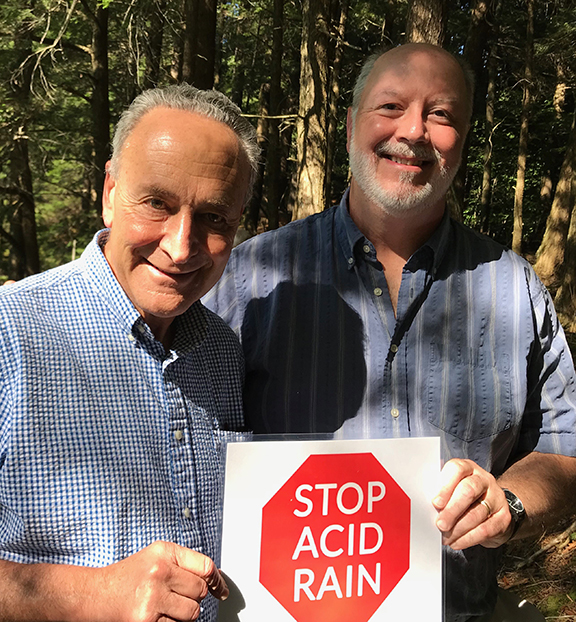
Sen. Schumer Visits Bear Pond to Defend EPA, Acid Rain Program - Calls for Continued Adirondack Acid Rain Research, End to Coal Promotion
UPPER ST. REGIS, N.Y. – U.S. Senate Minority Leader Charles Schumer, D-NY, visited remote Bear Pond in the Adirondack Park today to celebrate its recovery from decades of acid rain, while urging the Trump administration not to allow it to grow polluted again.
Senator Schumer also called on Congress to protect the U.S. Environmental Protection Agency’s (EPA) budget, especially EPA’s grants for acid rain research and recovery efforts in New York’s enormous and sensitive Adirondack Park.
Bear Pond is in the north-central section of the 9,300-square-mile Adirondack Park, about 30 miles northwest of Lake Placid, at the edge of the motor-free St. Regis Canoe Area.

“We thank Senator Schumer for reminding the Trump administration that it has an obligation to protect Bear Pond and the rest of the Adirondack Park from the coal-fired smokestacks of the Midwest,” said Adirondack Council Executive Director William C. Janeway. “Bear Pond is a perfect example of what the EPA’s air pollution rules have accomplished. It was almost dead, but Bear Pond is alive again! We could hardly have imagined this day 20 years ago. However, the park’s recovery is just beginning. If we go back to burning coal, we risk everything we have gained.”
When the EPA’s Acid Rain Program began in 1995, the pH of Bear Pond was 5.0. Water that acidic can support only a handful of the pond’s native species. Today, following significant reductions in the sulfur- and nitrogen-based air pollution (the causes of acid rain), the Adirondack Lakes Survey Corp. has reported that Bear Pond’s pH has risen to a more hospitable 6.0. In that range, a much broader variety of the pond’s native fish, insects and amphibians can survive.
The pH scale runs from 1 to 14. Neutral distilled water has a pH of 7. The closer it moves to 1, the more acidic; the closer to 14, the more alkaline. The scale also is logarithmic, meaning that an increase of a single unit is a tenfold rise.
So, Bear Pond is now 10 times more alkaline (less acidic) than it was in 1995.
“Today, we see a Bear Pond that has regained its ability to host native brook trout, as well as spotted salamanders and mayflies,” Janeway said. “This is a tremendous success story, brought to us by careful research in air and water chemistry and paid for by the EPA grants plus state and NYSERDA funds. The Adirondack Lakes Survey Corp exists because of those grants, and so do other great research teams around the country. It is an investment in our future and our children’s futures.”
Bear Pond’s recovery is great news for the Adirondack Park, which safeguards the world’s largest intact, temperate deciduous forest. The 9,300-square-mile park has suffered the nation’s worst acid rain damage.
Studies completed in the 1980s showed that 25 percent of its 2,800 largest lakes and ponds were critically acidified. Translation: more than half of their native life had been extinguished by changes in soil and water chemistry caused by acidic air pollution.
In addition, acidic water has caused widespread mercury contamination. Acids break down rocks and soil that contain harmless, inorganic mercury and convert it into an organic form that is readily absorbed by fish and insects in the water. One fish eats another fish or bug and over a lifetime, mercury grows more common in many species of fish, as well as in birds and mammals that eat fish, including people.
These problems and a host of others are illustrated in the Adirondack Council’s publication ACID RAIN: A Continuing National Tragedy. Bear Pond is mentioned in the publication and has been the subject of regular testing for decades.
The Adirondack Council helped persuade Congress to amend the Clean Air Act in 1990 and served on the EPA’s advisory council for the Acid Rain Program. The Council more than once called upon the late Sen. Daniel Patrick Moynihan to rescue the program’s funding when it was threatened by Congressional budget cuts.
The Council worked with Senator Schumer to rescue acid rain funding twice during the Bush (43) administration and again last year, when the House of Representatives proposed a 31-percent cut in the EPA’s funding. The continuing budget resolution approved for this year instead carried a modest increase for the EPA.
“New York’s Congressional delegation stood up for the EPA in 2018’s budget negotiations,” Janeway said. “The Adirondacks are grateful for that support. I am unhappy to report that we need it again.”
Founded in 1975, the Adirondack Council is a privately funded not-for-profit organization whose mission is to ensure the ecological integrity and wild character of the Adirondack Park. The Council envisions a Park with clean water and clean air, comprised of core wilderness areas, surrounded by farms and working forests, as well as vibrant communities.
The Adirondack Council carries out its mission through research, education, advocacy and legal action to ensure the legacy of the Adirondack Park is safeguarded for future generations. Adirondack Council members live in all 50 United States.
For more information:
John Sheehan
518-441-1340 cell
518-432-1770 office
FOR IMMEDIATE RELEASE: Friday, August 10, 2018




